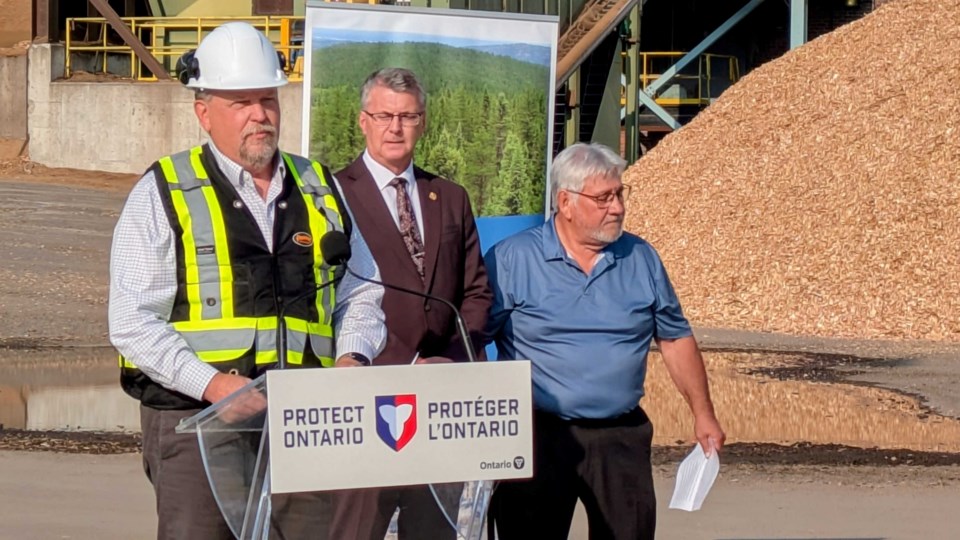THUNDER BAY – The province is giving $6.2 million in funding to eight biomass projects across Northwestern Ontario.
The Centre for Research and Innovation in the Bio-Economy, a non-profit in Thunder Bay, received the bulk of the funding. The research organization is getting $5 million over three years to advance the bio-economy throughout the province.
CEO Scott Jackson said one of the key initiatives for the funding is “targeted investment into the de-risking the supply chain” to help develop new technologies and biomass products.
“A key part of what we do is we work collaboratively with governments, with stakeholders, the private sector to really help understand where investment is needed and where we need to focus our attention,” Jackson said.
“It really is an organic approach to making sure that we focus our time and our attention appropriately and that we're putting our investments towards outcomes that have a strong chance of success, so trying to understand the markets that are there.”
Kevin Holland, associate minister of forestry and forest products, made the funding announcement at the Thunder Bay Pulp and Paper mill on Friday.
“I'm very proud to be here today to announce a total investment of over $6.2 million under the forest biomass program funding, which will support eight projects across northwestern Ontario, developing the untapped potential of underused wood and mill byproducts known as forest biomass,” Holland said.
“This versatile material is already used in landscaping and building materials and in heat and power generation, (with) many new and emerging uses as a source of renewable and alternative products and fuels, which can help to lower emissions and support the sustainability of our forests.”
The province is giving $1 million to four biomass projects in the north through the Indigenous Bioeconomy Partnerships funding stream.
Bingwi Neyaashi Anishinaabek (Sand Point First Nation) received $250,000 to fund a study on developing a biomass heating system in the community and purchase the equipment needed for converting wood chips produced by their sawmill into biofuel.
Chief Paul Gladu said this will lower energy costs and create new employment opportunities for community members, as well as “ensure the sustainability of our sawmill operation for years to come.”
“Sand Point is a displaced First Nation, having been forced off our land, and we only received our reserve lands back in 2010. We are now in the process of rebuilding our economy from the ground up, through the proper planning and the use of green technology like the biomass project. We are building our community using best practices and ensuring environmental sustainability is at its core,” Gladu said.
Kitchenuhmaykoosib Inninugug First Nation (Big Trout Lake) is receiving $249,544 for training activities, purchasing equipment, and developing a 10-year operational plan for forestry.
Pikangikum First Nation is receiving $160,996 to develop a 10-year operational forestry plan and train community members on forest health, sustainable harvesting practices, equipment maintenance and safety protocols.
Lake Nipigon Forest Management is receiving $250,000 to license, plan and develop a wood storage and merchandising yard for a regional biohub in Hurkett.
The province gave Thunder Bay Pulp and Paper $87,750 through the Exploring Biomass Pathways funding stream for additional research in designing upgrades to the boiler, fibre recovery, and sludge processing systems.
CEO Bill MacPherson said the processing system will allow the company to reclaim the waste from their products.
“We're excited about that because we want to find value in all parts of the manufacturing stream that starts with making the most out of a tree, which is where our value starts. We make lumber, wood products that is the highest value that other companies do,” MacPherson said.
“And out of them we take the waste stream, which are the chips, the leftover when you take a log, about 80 per cent of it can go into lumber, about 15 to 20 per cent is chips that might go to a landfill, so we could turn those into pulp useful products, along with green energy.”
Through the same funding stream, White River Forest Products is getting $130,000 to look into replacing its on-site boiler with a combined heat and pyrolysis energy plant, which could produce marketable products like biochar and biocoal.
Biopower in Atikokan is receiving $100,000 to fund a study of forest biomass as a potential source of renewable diesel.
